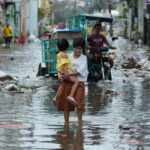
Typhoon Fung-wong has moved away from the northwestern Philippines after carving out a trail of devastation, leaving at least 10 people dead and 1.4 million displaced.
Known in the Philippines as Super Typhoon Uwan, the intense tropical storm was forecast to head northwest towards Taiwan.
- list 1 of 4Philippines assesses damage after deadly Typhoon Fung-wong
- list 2 of 4Photos: Typhoon Fung-wong kills at least 4 as it devastates the Philippines
- list 3 of 4COP30 summit in Brazil: What we know about the UN climate conference
- list 4 of 4Typhoon Fung-wong destroys homes in the Philippines
end of list
Fung-wong lashed the northern Philippines while the country was still dealing with the devastation wrought last week by Typhoon Kalmaegi, which killed at least 232 people in central provinces on November 4 before pummelling Vietnam, where at least five people died.
At least 10 people died due to flash floods, landslides, exposed electrical wires, and a collapsed house in the provinces of Catanduanes, Eastern Samar, Nueva Vizcaya, Mountain Province and Ifugao, disaster-response and provincial officials said.
Among the dead were three children who were hit by two separate landslides in the mountainous province of Nueva Vizcaya, police told The Associated Press news agency, adding four others were injured. Another landslide in nearby Kalinga province killed two villagers, and two others were missing, provincial officials said late on Monday.
Fierce wind and rain flooded at least 132 northern villages, including one where some residents were trapped on their roofs as floodwaters rapidly rose.
More than 4,100 houses were damaged, Bernardo Rafaelito Alejandro IV of the Office of Civil Defense and other officials said.
“While the typhoon has passed, its rains still pose a danger in certain areas” in northern Luzon, including in metropolitan Manila, Alejandro said. “We’ll undertake today rescue, relief and disaster-response operations.”
Advertisement
Fung-wong slammed ashore in northeastern Aurora province on Sunday night as a super typhoon with sustained winds of up to 185km/h (115mph) and gusts of up to 230km/h (143mph).
The 1,800km (1,100-mile)-wide storm weakened as it raked through mountainous northern provinces and agricultural plains overnight before blowing away from the province of La Union into the South China Sea, according to state forecasters.
More than 1.4 million people moved into emergency shelters or the homes of relatives before the typhoon made landfall, and about 240,000 remained in evacuation centres on Tuesday.

Philippine President Ferdinand Marcos Jr declared a state of emergency on Thursday due to the extensive devastation caused by Kalmaegi and the expected damage from Fung-wong.
Climate change is making tropical storms – which are known as hurricanes, cyclones and typhoons depending on where in the world they take place – more frequent and extreme, driven in part by warmer oceans that contribute more water vapour and heat.
The two super typhoons to batter the Philippines in one week come as representatives from governments around the world are gathering in the Brazilian city of Belem for the 30th annual United Nations Climate Change Conference (COP30) this week.
Many of the countries facing the worst impacts of climate change, like the Philippines, have done the least to contribute to causing the crisis due to their relatively small fossil fuel emissions.
They are now calling on the countries responsible for the climate crisis, which still spend about $1 trillion a year subsidising fossil fuels, to help pay for the costs of responding to climate disasters.
British Caribbean News


